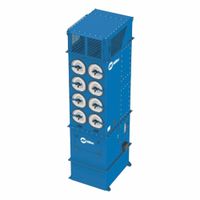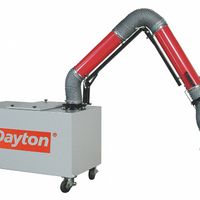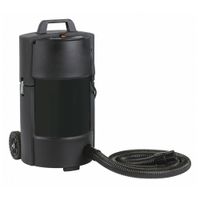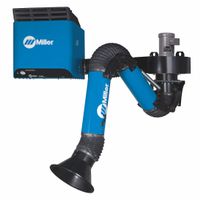Call +(254) 703 030 000 / 751 483 999 / 721 704 777
- Home
- Welding
- Welding Soldering Fume Extraction
- Fume Extractors
.....Read More
Frequently Asked Questions
What is a fume extractor and how does it work?
A fume extractor is a device designed to remove hazardous fumes, vapors, and particles from the air, ensuring a safer and healthier environment, particularly in industrial, laboratory, and manufacturing settings. These fumes can originate from processes like welding, soldering, chemical applications, and other activities that release airborne contaminants.
The primary components of a fume extractor include a capture hood or nozzle, a series of filters, a fan or blower, and an exhaust system. The process begins with the capture hood, which is strategically positioned near the source of the fumes. This hood collects the contaminated air and directs it into the extractor system.
Once inside, the air passes through a series of filters. The first stage typically involves a pre-filter that captures larger particles. Following this, the air moves through a high-efficiency particulate air (HEPA) filter, which is capable of trapping very fine particles, including those as small as 0.3 microns. In some systems, an activated carbon filter is also used to adsorb gaseous pollutants and odors.
The fan or blower is a crucial component that creates the necessary airflow to draw the contaminated air through the filters. It ensures that the air is effectively moved from the capture point through the filtration system and out of the exhaust.
Finally, the cleaned air is either recirculated back into the workspace or expelled outside, depending on the design and requirements of the system. By efficiently removing harmful substances from the air, fume extractors help maintain air quality and protect the health of individuals in environments where exposure to toxic fumes is a concern.
Why is it important to use a fume extractor during welding?
Using a fume extractor during welding is crucial for several reasons:
1. **Health Protection**: Welding produces hazardous fumes and gases, including metal oxides, silicates, and fluorides, which can be harmful when inhaled. Prolonged exposure can lead to serious health issues such as respiratory diseases, lung cancer, and metal fume fever. A fume extractor helps in capturing and removing these toxic substances from the air, reducing the risk of inhalation and protecting the welder's health.
2. **Regulatory Compliance**: Occupational safety regulations often mandate the use of fume extraction systems to ensure a safe working environment. Compliance with these regulations helps avoid legal penalties and ensures that the workplace meets health and safety standards.
3. **Improved Air Quality**: By removing harmful particles and gases, fume extractors significantly improve the air quality in the welding area. This not only benefits the welder but also other workers in the vicinity, contributing to a healthier overall work environment.
4. **Increased Visibility and Safety**: Welding fumes can obscure the welder's view, increasing the risk of accidents. A fume extractor clears the air, enhancing visibility and allowing the welder to work more safely and efficiently.
5. **Equipment Longevity**: Accumulation of welding fumes can damage equipment and electronic components over time. Fume extractors help in maintaining a clean environment, thereby extending the lifespan of tools and machinery.
6. **Environmental Responsibility**: Using fume extractors reduces the release of pollutants into the environment, aligning with sustainable practices and reducing the ecological footprint of welding operations.
In summary, fume extractors are essential for protecting health, ensuring safety, complying with regulations, and promoting environmental responsibility in welding operations.
What are the differences between mobile, portable, benchtop, and wall-mount fume extractors?
Mobile fume extractors are designed for flexibility and ease of movement. They are equipped with wheels or casters, allowing them to be easily transported to different locations within a workspace. These units are ideal for environments where fume extraction needs vary or where workstations are not fixed.
Portable fume extractors are compact and lightweight, making them easy to carry and set up in various locations. They are typically used for smaller, localized tasks and are suitable for temporary or short-term use. Their portability makes them convenient for fieldwork or situations where space is limited.
Benchtop fume extractors are designed to sit on a workbench or table. They are generally smaller and used for tasks that require fume extraction in a fixed position. These units are ideal for laboratory settings or small-scale operations where the work is consistently performed at a specific station.
Wall-mount fume extractors are installed on walls, saving floor space and providing a permanent solution for fume extraction. They are suitable for environments where workstations are fixed, and the extraction needs are consistent. Wall-mounted units are often used in industrial settings where space optimization and a fixed extraction point are priorities.
How do fume extractors help in meeting OSHA requirements?
Fume extractors help in meeting OSHA requirements by effectively controlling and reducing airborne contaminants in the workplace, thereby ensuring a safer and healthier environment for employees. OSHA mandates that employers maintain air quality standards to protect workers from hazardous substances, including fumes, dust, and vapors that can arise from various industrial processes such as welding, soldering, and chemical handling.
Fume extractors are designed to capture and filter out harmful particles and gases at the source before they can disperse into the workplace atmosphere. By doing so, they help in maintaining compliance with OSHA's permissible exposure limits (PELs) for various substances, which are legally enforceable standards that specify the maximum amount of a substance to which workers can be exposed.
These devices typically use high-efficiency particulate air (HEPA) filters or activated carbon filters to remove contaminants from the air. This filtration process is crucial in reducing the concentration of hazardous substances to levels below OSHA's PELs, thereby minimizing the risk of respiratory issues, chemical exposure, and other health hazards for workers.
Moreover, fume extractors contribute to meeting OSHA's requirements for engineering controls, which are preferred over personal protective equipment (PPE) as a means of hazard mitigation. By implementing effective fume extraction systems, employers demonstrate their commitment to proactive risk management and compliance with OSHA's hierarchy of controls.
In summary, fume extractors are essential tools in achieving OSHA compliance by ensuring that workplace air quality meets regulatory standards, thereby protecting worker health and safety and reducing the risk of legal liabilities for employers.
What types of filters are used in fume extractors?
Fume extractors utilize several types of filters to effectively capture and neutralize harmful particles and gases. The primary filters used include:
1. **Pre-Filters**: These are the first line of defense, capturing larger particles such as dust and debris. They extend the life of the more sophisticated filters by preventing clogging.
2. **HEPA Filters**: High-Efficiency Particulate Air (HEPA) filters are crucial for trapping fine particles, including dust, pollen, and smoke. They can capture particles as small as 0.3 microns with an efficiency of 99.97%.
3. **Activated Carbon Filters**: These filters are essential for adsorbing volatile organic compounds (VOCs) and odors. The activated carbon has a large surface area that effectively traps gases and chemical fumes.
4. **ULPA Filters**: Ultra-Low Penetration Air (ULPA) filters are even more efficient than HEPA filters, capturing particles as small as 0.12 microns with an efficiency of 99.999%.
5. **Electrostatic Filters**: These filters use an electrostatic charge to attract and capture particles. They are effective for smoke and fine dust but require regular cleaning to maintain efficiency.
6. **Chemical Filters**: These are specialized filters designed to neutralize specific chemical fumes. They often contain substances that react with the target chemicals to render them harmless.
7. **Metal Mesh Filters**: Used primarily in industrial settings, these filters capture larger particles and are washable and reusable, making them cost-effective for heavy-duty applications.
8. **Gas Phase Filters**: These filters are designed to remove specific gases and odors using chemical reactions or adsorption processes.
Each type of filter serves a specific purpose, and many fume extractors use a combination of these filters to ensure comprehensive air purification.
How often should fume extractor filters be replaced?
Fume extractor filters should typically be replaced every 3 to 6 months, depending on usage and the specific environment in which they are used. However, several factors can influence this timeline:
1. **Type of Filter**: Different filters, such as HEPA, carbon, or pre-filters, have varying lifespans. HEPA filters may last longer, while carbon filters might need more frequent replacement due to saturation with chemicals.
2. **Usage Frequency**: In environments with continuous or heavy use, such as industrial settings, filters may need to be replaced more frequently, possibly every 1 to 3 months.
3. **Type of Fumes**: The nature of the fumes being extracted also affects filter longevity. Filters dealing with corrosive or highly particulate-laden fumes may degrade faster.
4. **Manufacturer's Recommendations**: Always follow the manufacturer's guidelines for replacement intervals, as they are tailored to the specific design and capacity of the fume extractor.
5. **Performance Monitoring**: Regularly check the performance of the fume extractor. A noticeable decrease in suction power or an increase in odors can indicate that the filter needs replacement.
6. **Visual Inspection**: Periodically inspect filters for visible signs of wear, clogging, or damage. If the filter appears dirty or damaged, it should be replaced regardless of the time elapsed.
7. **Environmental Conditions**: In environments with high levels of dust or other airborne particles, filters may need more frequent replacement.
By considering these factors, you can determine the optimal replacement schedule for your fume extractor filters, ensuring efficient operation and maintaining a safe working environment.
Can fume extractors be used for other applications besides welding?
Yes, fume extractors can be used for various applications beyond welding. These devices are designed to remove airborne contaminants, making them versatile for different environments where air quality is a concern. Here are some applications:
1. **Soldering**: In electronics manufacturing, soldering produces fumes containing lead and other harmful substances. Fume extractors help in maintaining a safe working environment by capturing these fumes.
2. **Laser Cutting and Engraving**: These processes generate smoke and particulate matter. Fume extractors are used to remove these byproducts, ensuring clear visibility and protecting the health of operators.
3. **3D Printing**: Some 3D printing materials release volatile organic compounds (VOCs) and ultrafine particles. Fume extractors can mitigate these emissions, improving air quality.
4. **Pharmaceutical Manufacturing**: In this industry, fume extractors are used to control dust and chemical fumes, ensuring compliance with health and safety regulations.
5. **Chemical Laboratories**: Fume extractors are essential in labs to remove hazardous chemical vapors and maintain a safe working environment.
6. **Food Processing**: In food production, extractors can be used to remove smoke, steam, and odors, ensuring a clean and pleasant environment.
7. **Automotive Repair**: During processes like painting or using solvents, fume extractors help in removing harmful vapors and maintaining air quality.
8. **Woodworking**: Dust and fumes from varnishes or adhesives can be effectively managed using fume extractors.
9. **Metalworking**: Beyond welding, processes like grinding and cutting also produce dust and fumes that can be controlled with fume extractors.
In summary, fume extractors are versatile tools that can be adapted for various industrial, commercial, and laboratory applications to ensure a safe and healthy environment by controlling airborne contaminants.




